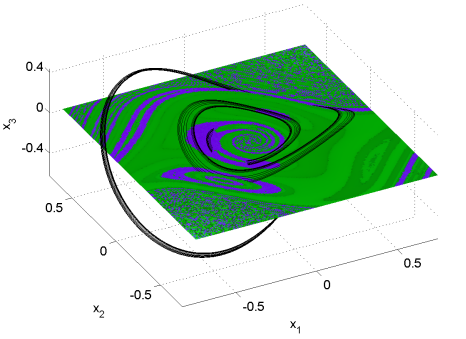Biorobotics Laboratory BioRob
Fritz Menzer (Diploma Thesis 2004)
Modeling transient behaviour in vocal fold vibration using bifurcating nonlinear ordinary differential equation systems
Goals:
- Study transient behaviour in the vibration of the human vocal folds
- Construct ODE systems that produce similar transient behaviour when they undergo bifurcations
 This project deals with a wide range of topics. Stationary and transient vocal fold movement was analysed. In particular pitch breaks (sudden changes in the fundamental frequency) with a non-integer frequency ratio were found to be interesting because this case is different from the classic period-doubling scenario.
This project deals with a wide range of topics. Stationary and transient vocal fold movement was analysed. In particular pitch breaks (sudden changes in the fundamental frequency) with a non-integer frequency ratio were found to be interesting because this case is different from the classic period-doubling scenario.
Modeling these pitch breaks with a system constructed like the Rössler system raised new hypotheses on pitch breaks. It turned out that some of these pitch breaks are not directly due to a bifurcation. Instead the system is perturbed to go from one attractor to another, both of which coexist for a given parameter range.
The model also raised the question if there may be a single mechanism responsible for pitch breaks to frequencies that are higher or lower than the normal vibration frequency.
A new physical model for the vocal folds was also developed, with the aim of keeping the number of state variables as low as possible. The result is a third order system having the contact area and the glottal airflow as state variables. In terms of the number of state variables this system is in the same class as a one-mass model driven by the glottal flow. However, it has more features than are usually found in a one-mass model. It also simulates the zipper-like opening and closing of the folds and takes into account a deformation of the vocal fold tissue.
An application of bifurcating nonlinear models could be to use them to drive real-time voice synthesis. This may contribute to a more natural sound. However, it must be considered that much of the naturalness of a sound has little to do with the vibration model itself, but with the way it is controlled.
Sounds - pitch break model
-
Before period doubling
After period doubling - double period
After period doubling - triple period
Before period doubling - double frequency component in third state variable
Triple, single and double periods without changing any model parameter
Sounds - Physical model driving a vocal tract model
Here is an example where the glottal flow of the physical model drives a vocal tract model (developed by Jack Mullen at the University of York). Normally this vocal tract model is driven by a waveform derived from the equations for glottal flow by Liljencrants and Fant (a.k.a. LF model).
It seems as if the voice source coming from the physical model produces less "buzziness" than the Lx waveform. Buzziness is an unwanted artifact of voice synthesizers. The LF model has this problem, probably because its derivative is discontinuous. On the other hand, the sound based on the simulated glottal flow sounds rather dull.
Odd stuff
- Archived student projects
- Alain Dysli
- Alexandre Tuleu
- Anurag Tripathi
- Ariane Pasquier
- Aïsha Hitz
- Barthélémy von Haller
- Benjamin Fankhauser
- Benoit Rat
- Bertrand Mesot
- Biljana Petreska
- Brian Jimenez
- Christian Lathion
- Christophe Richon
- Cédric Favre
- Daisy Lachat
- Daniel Marbach
- Daniel Marbach
- Elia Palme
- Elmar Dittrich
- Etienne Dysli
- Fabrizio Patuzzo
- Fritz Menzer
- Giorgio Brambilla
- Ivan Kviatkevitch
- Jean-Christophe Fillion-Robin
- Jean-Philippe Egger
- Jennifer Meinen
- Jesse van den Kieboom
- Jocelyne Lotfi
- Julia Jesse
- Julien Gagnet
- Julien Nicolas
- Julien Ruffin
- Jérôme Braure
- Jérôme Guerra
- Jérôme Maye
- Jérôme Maye
- Kevin Drapel & Cyril Jaquier
- Kevin Drapel & Cyril Jaquier
- Loïc Matthey
- Ludovic Righetti
- Lukas Benda
- Lukas Hohl
- Lukas Hohl
- Marc-Antoine Nüssli
- Martin Biehl
- Martin Riess
- Martin Rumo
- Mathieu Salzmann
- Matteo Thomas de Giacomi
- Matteo Thomas de Giacomi
- Michael Gerber
- Michel Ganguin
- Michel Yerly
- Mikaël Mayer
- Muhamed Mehmedinovic
- Neha Priyadarshini Garg
- Nicolas Delieutraz
- Panteleimon Zotos
- Pascal Cominoli
- Pascal Cominoli
- Patrick Amstutz
- Pedro Lopez Estepa
- Pierre-Arnaud Guyot
- Rafael Arco Arredondo
- Raphaël Haberer-Proust
- Rico Möckel
- Sacha Contantinescu
- Sandra Wieser
- Sarah Marthe
- Simon Blanchoud
- Simon Capern
- Simon Lépine
- Simon Ruffieux
- Simon Rutishauser
- Stephan Singh
- Stéphane Mojon
- Stéphane Mojon
- Sébastian Gay
- Vlad Trifa
- Yvan Bourquin
